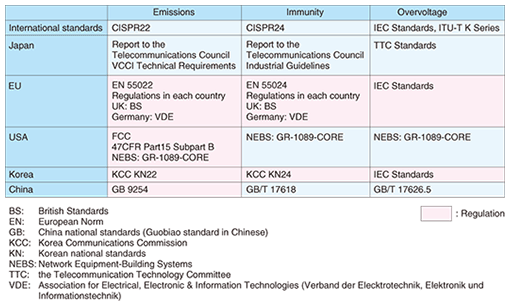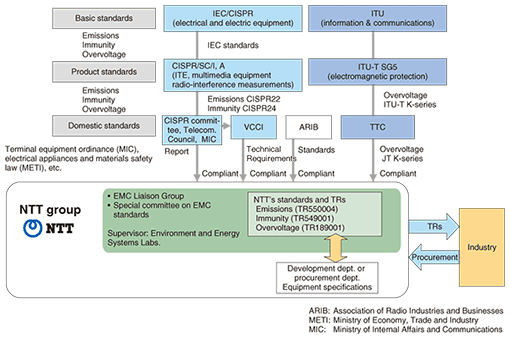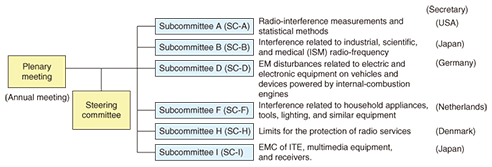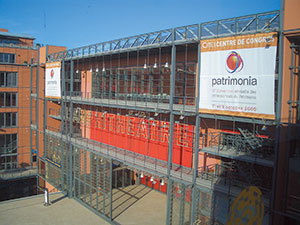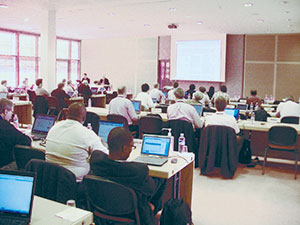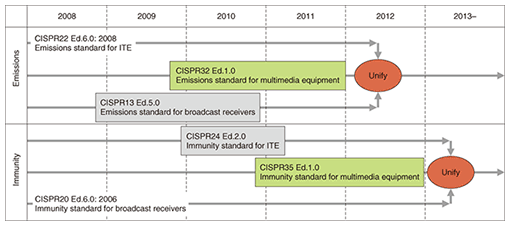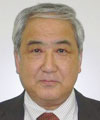 |
|||||||||||||||
|
|
|||||||||||||||
|
Global Standardization Activities Vol. 8, No. 2, pp. 39–44, Feb. 2010. https://doi.org/10.53829/ntr201002gls Standardization Activities in IEC/CISPR for Communications Electromagnetic Compatibility (EMC)AbstractThis article reports on the latest standardization activities for electromagnetic compatibility (EMC) for communications and summarizes the Plenary Meeting of IEC/CISPR 2009 held in Lyon, France, from September 21 to October 1, 2009, and the discussions conducted there on subjects related to telecommunications. EMC is an important issue for the NTT Group, which defines NTT Technical Requirements (NTT-TRs) in order to provide safe and secure telecommunications services.
1. IntroductionThe NTT Group establishes NTT Technical Requirements (NTT-TRs) for performance quality related to electromagnetic compatibility (EMC) for use in the development and procurement of telecommunications equipment. NTT-TRs specify the EMC requirements (acceptable values and measuring methods) needed to provide safe and secure telecommunications services related to emissions (of interfering electromagnetic waves), immunity (ability to resist electromagnetic waves), and overvoltage resistibility. The acceptable values and measuring methods specified in NTT-TRs conform to international standards for information technology equipment (ITE) and telecommunication equipment defined by IEC/CISPR (IEC: International Electrotechnical Commission, CISPR: Comite International Special des Perturbations Radioelectriques (International Special Committee on Radio Interference)) or ITU-T SG5 (International Telecommunication Union, Telecommunication Standardization Sector Study Group 5) and they should be complied with by enterprises in related industries both in Japan and abroad. Recently, as activities to protect the global environment have intensified, various telecommunication equipment design technologies related to energy saving, shielding, and grounding have emerged and new EMC issues have arisen. EMC is an aspect of environmental preservation efforts that concerns electromagnetic fields because it is concerned with managing the environment in which equipment is installed. 2. Overview of standardization on communications EMCThe application of EMC standards related to ITE and telecommunication equipment is regulated in each country on the basis of international standards. The legal status of standards on emissions, immunity, and tolerance to overvoltage in several countries is shown in Table 1.
In Japan, ITE emissions are controlled on a voluntary basis according to technical standards defined by the Voluntary Council for Information Technology Equipment (VCCI) (formerly Voluntary Control Council for Interference by Information Technology Equipment) in response to a report produced in 1985 by the Japanese national committee of CISPR, which was overseen by the then Ministry of Posts and Telecommunications (now the Ministry of Internal Affairs and Communications). This report, as well as the VCCI technical standards, conform to an international standard, CISPR22, issued by CISPR, which is a special committee of IEC. Most countries have legal regulations for ITE emissions, and violations result in legal sanctions. For example, in Europe there is an EU standard (EN55022) that must be met by equipment bearing the CE mark, while in the USA, there is FCC part 15, a Federal Communications Commission (FCC) standard. In Japan, a report from the Information and Communications Council, “Acceptable Values and Measuring Methods for Interfering Waves Emitted by Information Technology Equipment” (Version 5.2, 2007), added that the following information and communications technology (ICT) devices are excepted from the application of the regulations: (i) equipment in which the operation of information technology functions is secondary (e.g., industrial plant control equipment) and (ii) telecommunication equipment used only in buildings controlled by telecommunication carriers. The report explains that exceptions were added to adapt to Japan’s national conditions and to reduce the occurrence of problems regarding the application of the regulations by clearly identifying what types of equipment are excepted. These exceptions let telecommunication carriers formulate their own rules on emissions from telecommunication equipment installed in telecommunication centers (NTT-TR: TR550004 Version 3) [1] and require vendors to meet their EMC requirements by clearly prescribing these rules in their design specifications and procurement specifications (Fig. 1).
ITE immunity guidelines now in place in different industries in Japan have been developed in response to a 1998 report “Limit Values and Measuring Methods for the Immunity Properties of Information Technology Equipment” issued by the CISPR Committee of the then Telecommunications Technology Council (now Information Communication Council). In Europe, as in the case of emissions, there is an EU standard for immunity to interference (in this case, EN55024) that must be met by equipment bearing the CE mark and it carries legal force. The USA, like Japan, has no legal framework for immunity. In Japan, the report by the CISPR Committee excludes telecommunication equipment from the scope of the guidelines, as in the case of emissions. Therefore, the NTT Group has defined an NTT-TR (TR549001 Version 3) [2], which is an immunity standard conforming to the international standards CISPR24 and ITU-T Rec. K.48. The recent widespread use of Internet protocol (IP) equipment has resulted in the use of best-effort-based telecommunication equipment even for urgent communication and realtime services (audio and video). This has led to an increase in the number of EMC-related problems. To solve these problems, there are plans to enhance EMC-related quality in the domestic telecommunications industry through the formulation of standards by the Telecommunication Technology Committee (TTC) [3], [4]. NTT has developed an NTT-TR, “Technical Requirements for the Resistance of Telecommunication Equipment to Overvoltage, Version 1” (TR189001, issued on January 1, 2003), based on international standards (ITU-T K-series recommendations) [5] developed by ITU-T SG5 (Protection from effects of electromagnetic environment and climate change). In particular, taking into consideration the unique grounding practice in Japan, NTT has promoted standardization of the measuring methods and specifications for the overvoltage resistibility of telecommunication equipment installed in users’ premises. This has led to the development of guidelines by standards-related organizations in the telecommunications industry (by TTC, the Communications and Information Network Association of Japan (CIAJ), and others). The IP Network Facility Committee of the ICT Sub-council under the Information Communication Council is studying the development of legal regulations governing the technical requirements for overvoltage resistibility and the safety of telecommunication equipment based on ITU-T K-series recommendations and is also planning to establish specific guidelines. 3. 2009 CISPR Plenary Meeting in Lyon3.1 OutlineCISPR was established in 1934 as a special committee under the sponsorship of IEC in order to promote international trade by achieving international agreement on acceptable values and methods for measuring unwanted electromagnetic waves (interfering waves) that are emitted by various devices and cause radio disturbance. It comprises national delegates from radio regulatory authorities, broadcasting and telecommunications operators, other industries, universities, and other research organizations as well as people in international organizations concerned with suppressing radio disturbance. It currently has representatives from 40 countries (of which 12 are observers). The plenary meeting consists of six subcommittees (SC-A, SC-B, SC-D, SC-F, SC-H, and SC-I). Matters related to communications EMC are covered by the “Basic Specification for Radio Interference Measuring Tools and Methods” studied by SC-A and “Specification related to the Impact of Interfering Waves on Information Technology Equipment and Multimedia Equipment” studied by SC-I. In particular, an emissions specification (CISPR22) and an immunity specification (CISPR24) have been formulated and revised by SC-I (Fig. 2).
All the subcommittees met at the CISPR Plenary Meeting held at Centre des Congrès, Lyon, for nine days from September 21 to October 1, 2009. About 200 experts from 26 countries attended these meetings, including 31 delegates from Japan representing the Ministry of Internal Affairs and Communications and the National Institute of Information and Communications Technology as well as various enterprises, industrial associations, and other organizations. (Photos 1–3).
3.2 Major issues and discussionsAs mentioned above, the CISPR’s communications EMC standardization is intended to make it possible to develop or procure equipment that produces low emissions of interfering waves and has a low probability of experiencing faults due to lightning or electromagnetic interfering waves and to provide a stable telecommunication business service to customers. Among the issues discussed in Lyon, those closely related to NTT’s business included: (i) addition of impulse noise immunity testing methods for xDSL (digital subscriber line) equipment (SC-I) (ii) methods of measuring interfering waves and acceptable values for high-speed power line telecommunications (PLT) equipment (SC-I) (iii) specifications for alternative impedance stabilization networks (ISNs) (SC-A). Issue (i) concerns adding new immunity testing methods and requirements to an existing standard (CISPR24) and finalizing a new immunity standard (CISPR35) in order to prevent impulse noise induced on telecommunication or power lines from degrading the quality of xDSL communication. This is because an increase in the use of inverter control devices in homes is increasing the problem of impulse noise being induced on telecommunication or power lines and of adverse effects on nearby devices. It is extremely important to make efforts to solve EMC problems by adding new specifications to take account of the ongoing deterioration in the electromagnetic environment. This issue was discussed in the Lyon meeting, and it is almost certain that the necessary addition will be included in CISPR24 Version 2. (Discussions on the addition to CISPR35 are still ongoing.) Issue (ii) concerns the addition of methods of measuring interfering waves from PLT devices and acceptable values to an existing standard (CISPR22). Separate studies are being undertaken for the specifications for PLT devices used indoors and outdoors (PLT devices used in access networks). In Japan, the Radio Law has already been revised and has been applied to indoor PLT devices. (The use of PLT devices in access networks is prohibited by law.) Japan submitted a proposed specification based on the one in the Radio Law. However, different specifications that partially relax the acceptable values in CISPR22 were proposed mainly by European contributors, and a long discussion has subsequently ensued. This question was also discussed at the Lyon meeting in September. In light of the failure to achieve consensus despite the remaining study period being less than one year, it was decided that the opinions of national committees of participating countries will be collected in order to decide either to adopt a specification rapidly, on the basis of the currently available proposed drafts, or to make a fresh start and study this issue as a maintenance item for CISPR22. Regarding issue (iii) concerning ISNs needed when measuring conductive interfering waves at communication ports, Japan adopted the following two polices for the Lyon meeting:
However, it was decided not to discuss issue (iii) at this stage because the project in CISPR SC-I is likely to restart. In Japan, the application of VCCI regulations for the specification of conducting interfering waves on communication ports will start in April 2010. Discussions will be continued to support the study of more accurate, simpler, and less expensive measuring methods, including alternative measuring methods for PLT ports. 4. Concluding remarksThis article described the relationship between NTT’s EMC rules and international standards (IEC/CISPR and ITU-T), major issues being studied in CISPR, and discussions held in the 2009 Lyon meeting. CISPR will continue to formulate new standards and replace existing ones to reflect changes in equipment, such as the disappearance of the separation between telecommunication equipment and broadcasting equipment, and changes in the electromagnetic environment, such as the introduction of PLT and other new systems, and an increase in impulse noise (Fig. 3). To continue to provide stable telecommunication business for customers, NTT believes that it is important to participate actively in international standardization activities and promote internal regulations that are responsive to changes in the external environment.
References
|
|||||||||||||||








